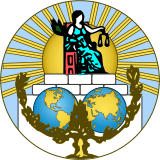North Sea Continental Shelf cases
| North Sea Continental Shelf | |
|---|---|
 | |
| Court | International Court of Justice |
| Full case name | North Sea Continental Shelf (Federal Republic of Germany/Netherlands) |
| Decided | February 20, 1969 |
| Case opinions | |
|
Declaration attached to Judgment: Muhammad Zafrulla Khan | |
| Court membership | |
| Judges sitting |
José Bustamante y Rivero (President) Vladimir Koretsky (Vice President) Sir Gerald Fitzmaurice Kōtarō Tanaka Philip Jessup Gaetano Morelli Muhammad Zafrulla Khan Luis Padilla Nervo Isaac Forster Andre Gros Fouad Ammoun César Bengzon Petrén Sture Petrén Manfred Lachs Mosler (ad hoc for Germany) Max Sørensen (ad hoc for The Netherlands) |
Germany v Denmark and the Netherlands [1969] ICJ 1 (also known as The North Sea Continental Shelf cases) were a series of disputes that came to the International Court of Justice in 1969. They involved agreements among Denmark, Germany, and the Netherlands regarding the "delimitation" of areas—rich in oil and gas—of the continental shelf in the North Sea.
Facts
Germany's North Sea coast is concave, while the Netherlands' and Denmark's coasts are convex. If the delimitation had been determined by the equidistance rule ("drawing a line each point of which is equally distant from each shore"), Germany would have received a smaller portion of the resource-rich shelf relative to the two other states. Thus Germany argued that the length of the coastlines be used to determine the delimitation.[1] Germany wanted the ICJ to apportion the Continental Shelf to the proportion of the size of the state's adjacent land and not by the rule of equidistance.
Judgment
The Court ultimately urged the parties to "abat[e] the effects of an incidental special feature [Germany's concave coast] from which an unjustifiable difference of treatment could result." In subsequent negotiations, the states granted to Germany most of the additional shelf it sought.[2] The cases are viewed as an example of "equity praeter legem"—that is, equity "beyond the law"—when a judge supplements the law with equitable rules necessary to decide the case at hand.[3]
